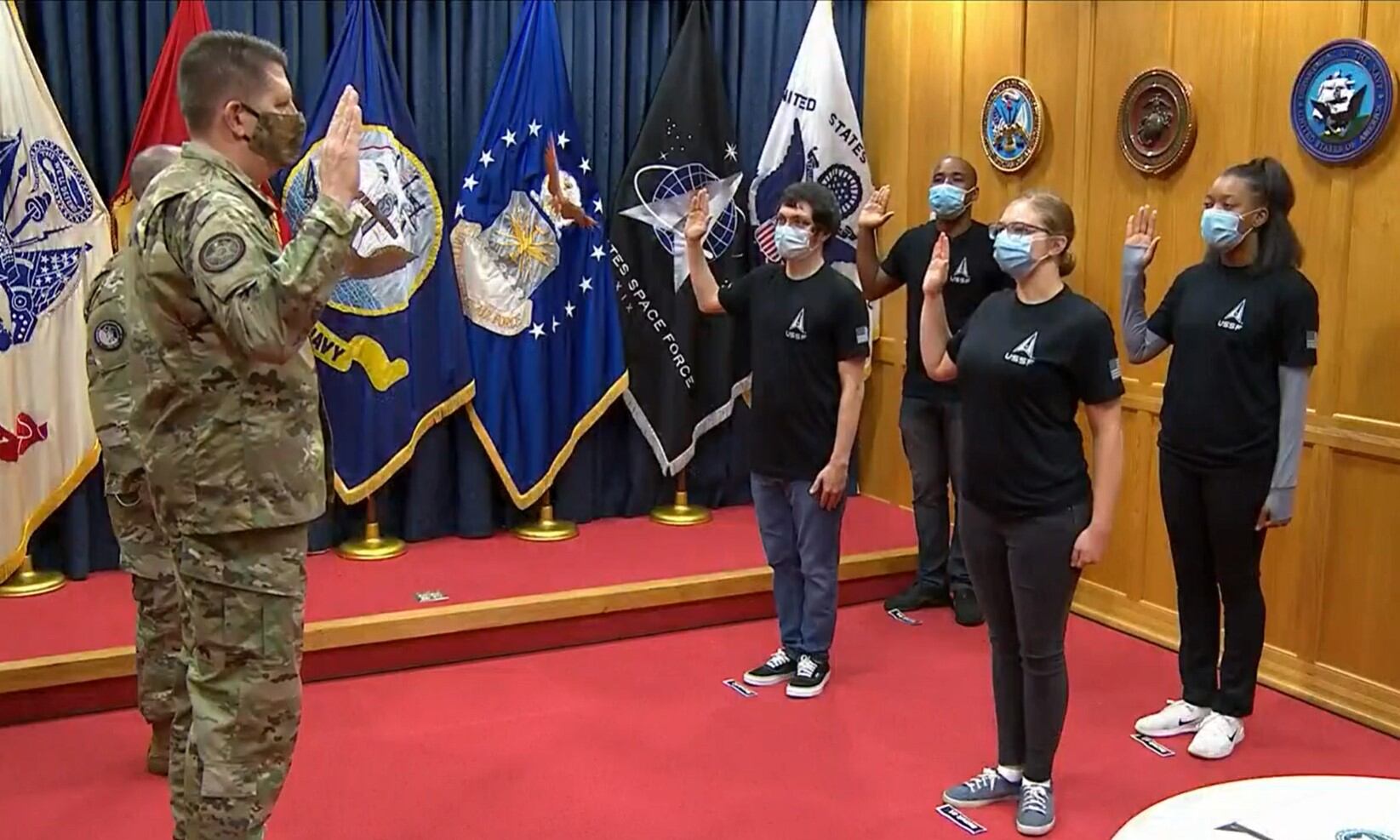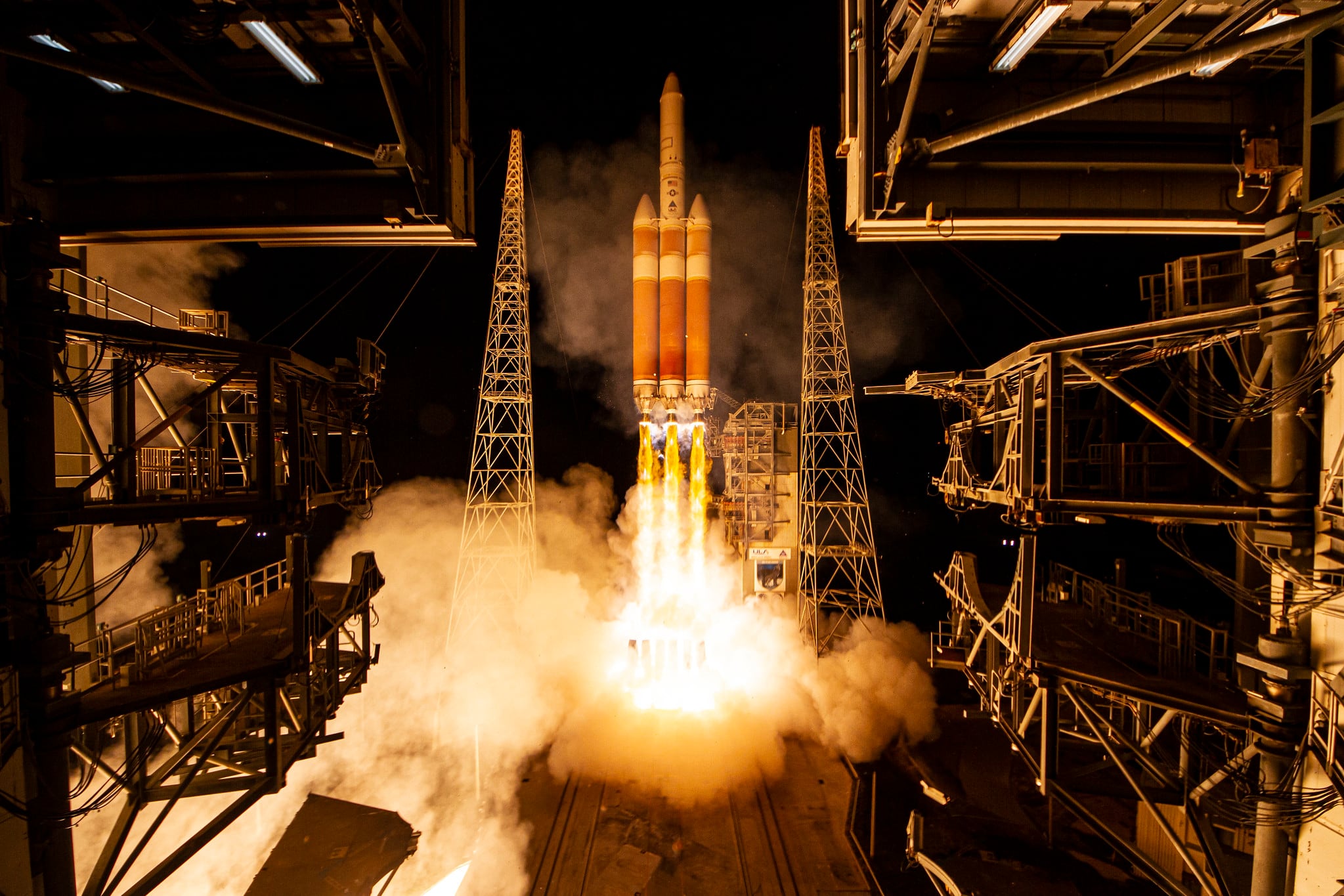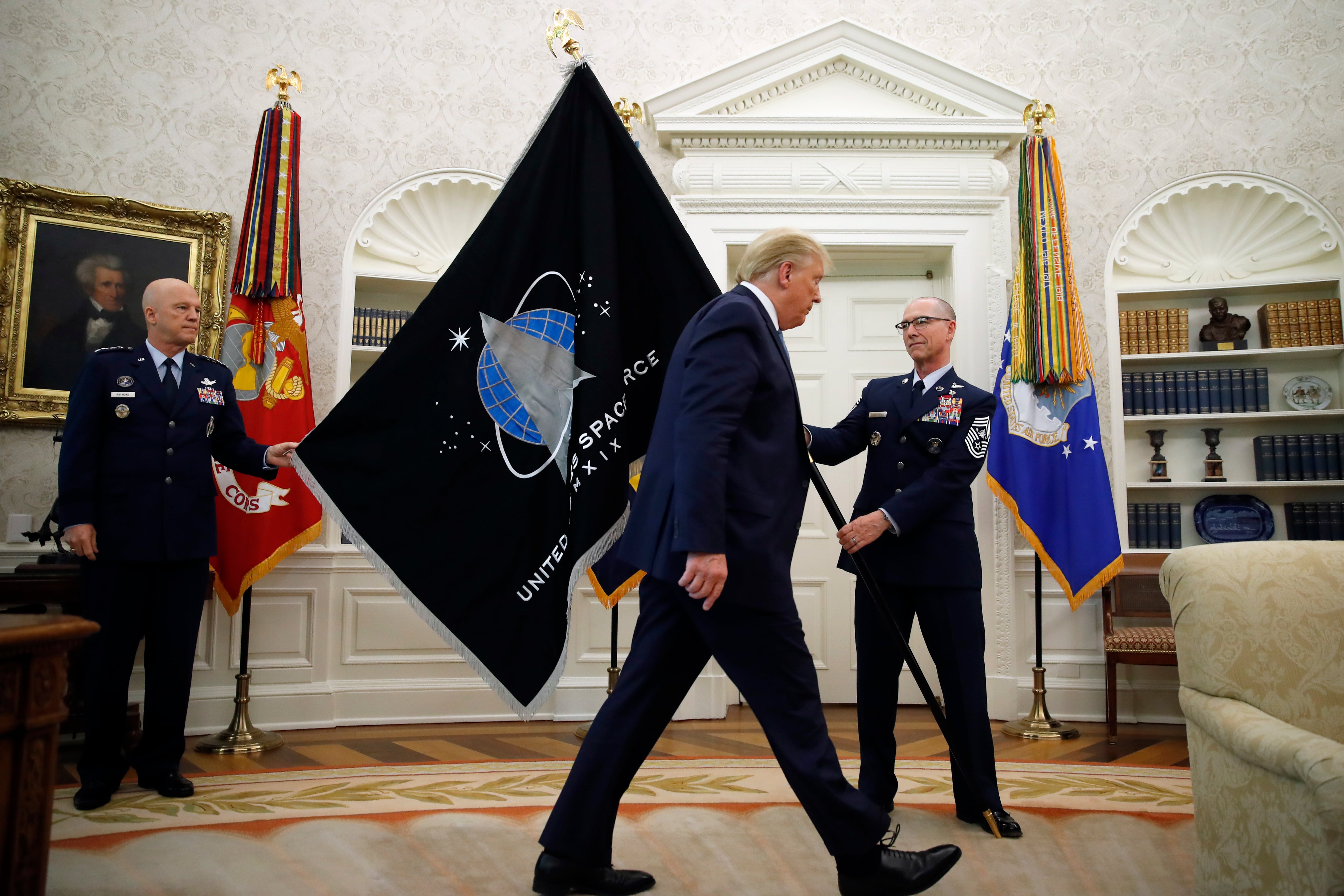WASHINGTON — When leaders gathered at the White House to commemorate the first birthday of the Space Force, it was supposed to be a celebration. Instead, the new military branch stumbled into another public relations quagmire after Vice President Mike Pence announced that members of the service would be called “guardians.”
The announcement immediately reverberated through social media, with celebrities and mainstream news outlets mocking what seemed to be yet another instance of the Trump administration pilfering pop culture for a military organization that — at least to some — has always seemed more like a joke than a serious policy endeavor.
“Can we sue this dork?” tweeted James Gunn, who directed the two “Guardians of the Galaxy” films, which are part of the blockbuster Marvel Cinematic Universe.
Mark Hamill, the actor best known for starring as Luke Skywalker in the “Star Wars” films, fired back a response to Gunn.
“So they grab the ‘Guardians’ from your movies, they use the ‘Force’ from our movies... then they have the gall to just steal their logo from ‘Star Trek’? Let’s file a 3-way joint lawsuit & really nail these larcenous bastards!”
New York Magazine ran a story that began: “Mr. Biden, I beg you: Abolish the Space Force.”
For opponents of the Space Force, however, that may be easier said than done.
President-elect Joe Biden, for his part, has given no indication that he will seek to overturn the creation of the Space Force, said Todd Harrison, an aerospace and budget expert with the Center for International and Strategic Studies.
“It’s fair to say that if the Space Force did not exist right now, the Biden administration probably wouldn’t create it,” he said. “But now that it does exist, I think that they’re going to work with it and try to continue the implementation of it.”
That leaves the new administration with a problem: For much of the public, the Space Force is seen as a vanity project of Trump’s instead of a long-debated military organization necessary to ensure that the Defense Department can counter Russian and Chinese threats.
Trump has bolstered that perception in his own public statements, telling troops during a teleconference last Thanksgiving that “nobody even thought about the Space Force” before him.
“I looked at it, and I said — I said: ‘We’re going to have to come up — we’re going to have to do something,’ ” Trump said Nov. 26. “Because I looked at what China was doing and Russia was doing and others are thinking about doing.”
So how does “Trump’s Space Force” become “America’s Space Force?”
Do or do not — there is no try
The Space Force, as it exists now, is fundamentally a rebranding of the Air Force’s legacy space organizations — specifically the now-defunct Air Force Space Command. The service currently controls about $15 billion in annual spending, commands dozens of military satellites and tracks more than 24,000 objects in space.
Though Trump has often sought to take credit for establishing the Space Force, debate about a separate service branch for space originated in 2017 and was led by a bipartisan duo of lawmakers: Reps. Mike Rogers, R-Ala., and Jim Cooper, D-Tenn., who led the House Armed Services Committee’s Strategic Forces Subcommittee.
The lawmakers criticized the Air Force for overlooking the importance of space, and they proposed the concept of a “Space Corps.”
Its main opponents were Republican lawmakers — mostly in the Senate — who backed the Air Force’s position that removing space operations from the service could erode performance in current missions, such as running the nation’s GPS constellation and detecting the launch of ballistic missiles.
But when Trump ordered the creation of a Space Force in June 2018, both Air Force officials and Republican lawmakers fell in line. In December 2019, Congress established the Space Force through the annual National Defense Authorization Act.
It would take another act of Congress to abolish the Space Force from U.S. law, as well as a massive bureaucratic effort to revert military space organizations back to how they were set up before the Space Force was established, said Brian Weeden, director of program planning for the Secure World Foundation and a former space operations officer for the Air Force.
All of that would require political capital that the Biden administration is going to need to spend elsewhere, said Weeden, who initially opposed creating a space service. “It’s just not worth it,” he said. “At this point we have spent thousands and thousands of hours and years of effort to create this new bureaucracy in the hope that it will address these challenges. At this point, we have no choice but to see that through. To now go back and spend even more time undoing all this stuff would be even worse.”

Trump has touted the Space Force as a signature achievement of his presidency. But his involvement in standing up of the service has been controversial.
“President Trump’s rhetoric has created a false perception in the public,” Weeden said. “You have people imagining that we’re going to have Marines on Mars and fighters in space and all kinds of crazy stuff. That is not the case.”
Some of those misperceptions have been self-inflicted by the Space Force itself, such as a July advertisement featuring a female guardian wearing a spacesuit and narrating about space exploration.
However, the president has also set out to connect the Space Force with the Trump brand — even going so far as to sell unofficial Space Force hats on his reelection website.
A July article in Time magazine described how the president was given the authority to choose the Space Force’s seal. Days later, he tweeted the seal with no notice to the Defense Department, which reportedly led to a conference call between defense officials and executives from Paramount Pictures concerned about the seal’s similarity to the “Star Trek” logo.
Trump also suggested to military officials that his wife, first lady Melania Trump, could help design uniforms for the new service, Time reported. That plot point was later parodied on the 2020 Netflix comedy series “Space Force,” in which Steve Carrell portrays a bumbling Air Force general who is tapped to lead the new space service.
“One of the biggest things we have to overcome is that there’s a Netflix series making fun of the Space Force,” said Mandy Smithberger, director of the Straus Military Reform Project at the Project for Government Oversight. “If the public has been thinking about it all, the reputation of the Space Force — in public imagination — is one of incompetence.”
Harrison, of the Center for International and Strategic Studies, said Biden could take a more hands-off approach with the Space Force, allowing it to normalize itself with time and giving service officials the opportunity to lead the conversation.
“Just by not making a big show of interfering with it, that may help depoliticize it,” he said.
“But I personally think that might not be enough,” he added. “The way the Space Force was presented to the general public has not been healthy. It has not helped educate people about what the military does in space. It has caused more people to become confused about what the Space Force does versus what NASA does.”
To boldly go …
If the Space Force is going to win over the broader public, it needs to make some changes, experts agreed.
First, the Space Force should clarify exactly what the service is going to do and not do in space. “For example, the Space Force isn’t going to have people on the moon. The Space Force is talking about satellites in Earth orbit or cislunar space that can get better awareness of activities in cislunar space,” Weeden said.
Beyond that, the Space Force must lead a broader public discussion about how far the U.S. military should be willing to go to deter attacks against its space-based assets, he added.

Service officials have been clear about the threat posed to the United States as adversaries focus on testing technologies meant to disrupt or destroy U.S. satellites. Most recently, in December, Russia conducted its second direct-ascent anti-satellite missile test of 2020.
However, the amount of money the Space Force plans to invest in its offensive counterspace capabilities is less clear, given the classification of those programs.
“Overclassification is a huge problem. We can’t communicate what we have. We can’t communicate the problem,” Weeden said. “We can’t deter if we can’t talk about this stuff. Yet despite multiple [four-star generals] saying [declassification] is a top priority, I haven’t seen anything change.”
Harrison and Weeden agreed the service needs to reestablish the firewall between civil and military space, as the line between NASA and the Space Force has been blurred by Trump and some of his top politicians.
“If you carefully read the actual policy documents, it makes that [distinction] clear. It’s just that nobody ever reads those except for wonks like me. Most people only really see what Trump says,” Weeden said. “Substantively, most of what’s going on is good. The change mostly needs to be in the public rhetoric and discussion about what we’re doing.”
Harrison pointed to the December announcement of NASA astronaut Mike Hopkins transferring to the Space Force while in orbit at the International Space Station. While many military personnel have worked as astronauts, they do so in a civilian capacity.
“That really confuses the message” Harrison said.
Officials such as Gen. John “Jay” Raymond, the chief of space operations, are trying to set the record straight on the Space Force’s purpose and the importance of the military’s operations in space, Weeden said.
“I think there’s a realization amongst nations that access to space is no longer a given,” Raymond said in a Nov. 25 Defense Department news story. “We’ve got to make sure that we stay ahead of this growing threat.”
Still, “no one can contradict Trump. So when they do make clarifications it’s sotto voce or through channels that are less apparent than Trump’s original comments,” Weeden said.
To give Space Force a communications strategy that prioritizes its own needs, Harrison said the service should stand up its own public affairs and legislative liaison offices instead of conducting those activities through the Air Force, as it currently does.
“They’ve got to learn from the Marine Corps there, that they are part of the Department of the Air Force but they are not run by the Air Force,” Harrison said. “They’ve got to have the ability to develop their own independent messages as a military service. That would help a lot with their public image.”
Never give up. Never surrender.
The transition of personnel, equipment and funding to the Space Force is still a work in progress, but several major changes are planned for this year.
Chief Master Sgt. Roger Towberman, the service’s top enlisted adviser, told Military.com the service is working to solidify much-anticipated cultural touchstones, such as the Space Force song, dress uniform and rank structure.
“It’s about listening to everyone,” he said in an interview. “We feel we can craft a service narrative that both honors military traditions and speaks to the things that we want them to speak to: the essence of our service, the future of our service.”
By the end of 2021, the size of the Space Force will have tripled from about 2,400 active-duty members to about 6,400 people, Raymond said in December. Some of those personnel, he said, could be the first space operators transferring into the Space Force from the Army or Navy.
The Space Force also intends to stand up a new space acquisitions organization, called Space Systems Command, in 2021. SSC will be home to Space and Missile Systems Center, the Space Rapid Capabilities Office, and the Space Development Agency — as well as, potentially, other space procurement organizations from the Army and Navy.
That’s something Harrison said he’ll be keeping an eye on this year.
“They need to make sure they don’t leave any organizations or any programs in those other services that are clearly without a doubt building space systems,” he said. The Space Force should also “continue to transfer all of the budget accounts, including the [military personnel] accounts, from the Air Force. Because if you don’t control your own budget, then you’re not a real service.”
To keep the development of several new space systems on track — such as the Next Generation Overhead Persistent Infrared constellation of missile warning satellites — Harrison said the Space Force budget will likely continue to grow, although perhaps not as rapidly as under the Trump administration.
However, the Biden administration should also keep pressure on the Space Force to minimize bureaucratic overhead and prevent duplication with other services, said Smithberger, of the Project for Government Oversight.
“The amount of money going to the Space Force should be low and slow as they prove they can be responsible stewards,” she said. “I think if we send a lot of money to that service, we would be increasing program risk unnecessarily.”
Valerie Insinna is Defense News' air warfare reporter. She previously worked the Navy/congressional beats for Defense Daily, which followed almost three years as a staff writer for National Defense Magazine. Prior to that, she worked as an editorial assistant for the Tokyo Shimbun’s Washington bureau.



